
Kaunas is the second-largest city in Lithuania after Vilnius, the fourth largest city in the Baltic States and an important centre of Lithuanian economic, academic, and cultural life. Kaunas was the largest city and the centre of a county in the Duchy of Trakai of the Grand Duchy of Lithuania and Trakai Palatinate since 1413. In the Russian Empire, it was the capital of the Kaunas Governorate from 1843 to 1915.

The Neman,Niemen or Nẽmunas is a river in Europe that rises in central Belarus and flows through Lithuania then forms the northern border of Kaliningrad Oblast, Russia's western exclave, which specifically follows its southern channel. It drains into the Curonian Lagoon, narrowly connected to the Baltic Sea. The 937 km (582 mi) long Neman is a major Eastern European river. It flows generally west to Grodno within 12 kilometres (7.5 mi) of the Polish border, north to Kaunas, then westward again to the sea.
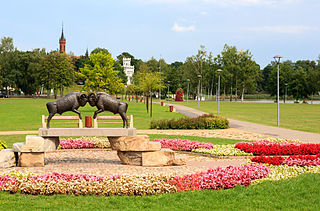
Druskininkai is a spa city on the Nemunas River in southern Lithuania, close to the borders of Belarus and Poland. The city of Druskininkai is known for being a spa resort since the 19th century.

Alytus is a city with municipal rights in southern Lithuania. It is the capital of Alytus County. The population as of July 2024 was 50,996. Alytus is the historical centre of the Dzūkija region. The city lies on the banks of the Nemunas River. The major roads linking Vilnius, Kaunas, Lazdijai, and Grodno in Belarus pass through Alytus.

Kelmė is a city in northwestern Lithuania, a historical region of Samogitia. It has a population of 8,206 and is the administrative center of the Kelmė District Municipality.
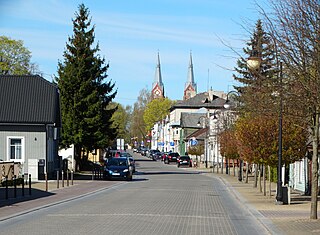
Jurbarkas is a city in Tauragė County, in Samogitia, Lithuania. Jurbarkas is located in the historic land of Karšuva. It is on the right-hand shore of the Nemunas at its confluence with the tributaries Mituva and Imsrė. The town became an important road junction after a bridge was built over the Nemunas in 1978.

Merkinė is a small town in Alytus County. The town belongs to the Varėna District Municipality and is located about 26 kilometers west of Varėna.

Kaunas District Municipality is one of 60 municipalities in Lithuania. The seat of the municipality is the city of Kaunas, which does not belong to the municipality but is a separate administrative unit. It surrounds the Kaunas City Municipality from the north, west and south, while in the east Kaunas district municipality borders Kaišiadorys District Municipality. Kaunas District Municipality has the second largest international airport in Lithuania, and is well connected by major roads, as well as railways with other cities of Lithuania.

Rumšiškės is a Lithuanian town, situated 20 km (12 mi) east of Kaunas on the northern bank of Kaunas Reservoir. Southern part of the town is now under the waters of the artificial lake. The 18th century St. Michael Archangel church of Rumšiškės was saved and moved to its present place in 1958, when the reservoir was created.
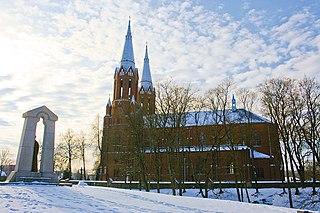
Anykščiai is a ski resort city in Lithuania, 20 miles west of Utena. The Roman Catholic Church of St. Matthias in Anykščiai is the tallest church in Lithuania, with spires measuring 79 metres in height. Anykščiai has a resort status in Lithuania and is a popular destination of domestic tourism.

Birštonas is a balneological resort and a spa town in Lithuania situated 30 km (19 mi) south of Kaunas on the right bank of the Nemunas River. Birštonas received its city rights 1529 and was appointed a city in 1966. The city is the administrative centre of the Birštonas municipality.

Simnas is small town on the river Dovinė between Simnas and Giluitis lakes, in Alytus district, Alytus county, in the south of Lithuania. It lies on the 131 a national primary road from Alytus to Kalvarija. Simnas is located within the ethnographical region Dzūkija. According to the 2022 data, 1209 people live in the town with 3148 in Simnas eldership. It is most populous settlement in Alytus district.

Seda is a city in Mažeikiai district municipality, Lithuania. It is 24 km (15 mi) south-west of Mažeikiai on the Varduva River. There are two churches in the town.

Troškūnai is the second smallest city in Lithuania. It is located 14 km (8.7 mi) west from Anykščiai.

The Aleksotas Eldership is an eldership in the southern section of the city of Kaunas, Lithuania, bordering the left bank of the Nemunas River. Its population in 2006 was 21,694. The elderate borders Vilijampolė and Centras in the north, Šančiai and Panemunė in the east, Garliava in the south as well as Akademija in the west.

Antanas Mackevičius was a Lithuanian Roman Catholic priest who was one of the leaders and initiators of the January Uprising in Lithuania.[a]
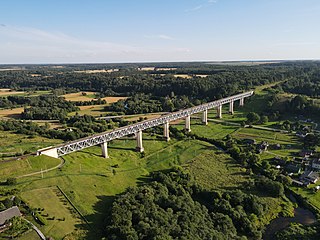
Lyduvėnai is a small town in the Šiluva Eldership, Raseiniai District Municipality, Kaunas County in central Lithuania. The town is 15 km north of Raseiniai and is near the confluence of the Dubysa and Dratvuo rivers. Lyduvėnai is the home of the longest and highest railway bridge in Lithuania, the Lyduvėnai Bridge. The town possesses the eldership's center, has a railway stop, a school, a library, in addition to post. The town's postal code is LT-60046. Lyduvėnai is situated in the Dubysa regional park and has its information center in the town's school. The railway line Šiauliai–Tilžė and the highways to Raseiniai and Šiluva pass through Lyduvėnai. Lyduvėnai is in the Dubysa valley, in contrast to other towns in the Dubysa basin.
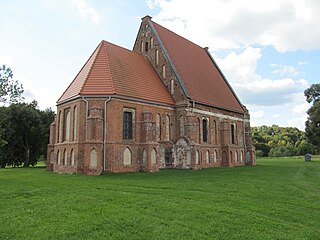
Zapyškis is a small town in Kaunas County in central Lithuania on the left bank of the Nemunas River. As of 2011 it had a population of 264.

Viešintos is a town in Anykščiai district municipality, in Utena County, in northeast Lithuania. According to the 2011 census, the town has a population of 281 people. Town established near Viešinta river.

Antanavas is a village in Marijampolė County, Lithuania, the center of an eldership. The village belongs to the Kazlų Rūda Municipality and is located about 15 kilometers south-west of Kazlų Rūda. The river Pilvė flows along the northern edge of the village. Near Antanavas there is a hydroelectric power station. According to the 2021 Lithuanian census, the village had a population of 562 residents.

























